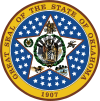Little Dixie (Oklahoma)

Little Dixie is a name given to southeast Oklahoma, which in the past was strongly influenced by southern "Dixie" culture as its white settlers were chiefly Southerners seeking a start in new lands following the American Civil War. In addition, it incorporated lands of some of the Five Civilized Tribes who had been removed from the Southeast. A number were slaveholders, and they generally allied with the Confederacy during the Civil War.
The Oklahoma tourism department also refers to this area as "Choctaw Country," formerly "Kiamichi Country," but the Little Dixie region is not clearly defined: its exact boundaries vary by source. It falls mostly within the Choctaw Nation of Oklahoma's tribal area, as well as some Chickasaw and Muscogee Creek lands.[1] During the tenure of US Representative Carl Albert, it was still the 3rd Congressional district of Oklahoma. Redistricting has since changed the geographical boundaries[2]
Several towns and cities in southeast Oklahoma use the Little Dixie name, and that helps to define the boundaries. A radio station in McAlester is owned by "Little Dixie Radio, Inc."[3] The band at the public high school in Tishomingo, former capital of the Chickasaw Nation, is called The Pride of Little Dixie.[4] When President Harry Truman visited Marietta in Love County in 1948, he gave a speech saying it was a pleasure to be in the Little Dixie region of Oklahoma.[5]
Leaves of Grass, a 2010 film starring Edward Norton, is set mostly in Little Dixie.[citation needed]
See also[]
- Choctaw Country
- Franks, Kenny Arthru and Lambert, Paul F. Oklahoma: The Land and Its People, Norman: University of Oklahoma Press. 1997.
References[]
- ^ Extensions Archived 2007-03-20 at the Wayback Machine
- ^ Carl Albert Online Exhibit Archived 2007-07-08 at the Wayback Machine
- ^ http://www.fcc.gov/Bureaus/Mass_Media/Public_Notices/Brdcst_Actions/ac970703.txt
- ^ The Official Site of Tishomingo Public Schools /Band Archived 2006-09-28 at the Wayback Machine
- ^ Truman Library - Public Papers of the Presidents: Harry S. Truman
- Regions of Oklahoma
- Regions of the Southern United States

